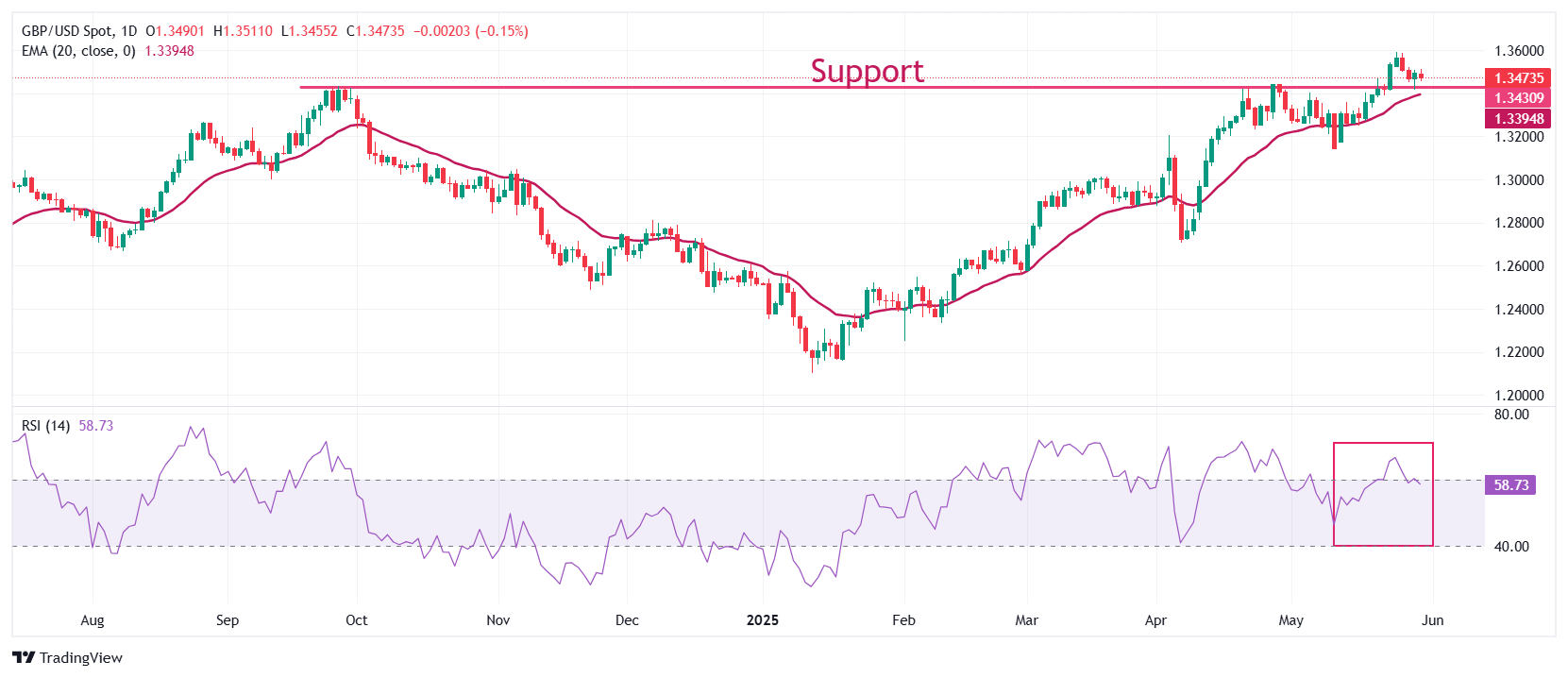-
The Pound Sterling dips slightly to around 1.3475 versus the US Dollar as the Greenback sees a modest rebound.
-
A U.S. federal appeals court has temporarily halted a lower court ruling against Trump-era tariffs.
-
Market participants look ahead to the release of April’s US PCE inflation data.
The Pound Sterling (GBP) edged lower to around 1.3475 against the US Dollar (USD) during Friday’s European session. Despite the dip, the GBP/USD pair remains on track to close May with gains for the fourth consecutive month.
The UK currency has been supported by expectations of a moderate monetary easing cycle from the Bank of England (BoE), along with progress in trade negotiations with the United States, India, and the European Union. Meanwhile, the US Dollar continues to face pressure amid ongoing uncertainty surrounding former President Donald Trump’s tariff policies.
According to a Reuters report, futures markets are pricing in a total rate cut of approximately 38 basis points by year-end, suggesting one full 25 bps cut with a 50% probability of a second.
On Thursday, BoE Governor Andrew Bailey emphasized a "gradual and careful" approach to rate cuts, citing lingering inflation risks, particularly in food and other product categories. He also noted that the UK labor market remains largely in line with expectations, with wage growth continuing to slow.
The pullback in dovish expectations for the BoE has been driven by stronger-than-expected Q1 economic performance and persistently elevated inflation figures.
Adding to the positive sentiment, the International Monetary Fund (IMF) slightly upgraded its UK GDP growth forecast for 2025 to 1.2%, up from 1.1%. The revision follows robust Q1 GDP data, which showed a 0.7% expansion—significantly higher than the 0.1% growth recorded in the final quarter of 2024.
Daily Digest Market Movers: Pound Sterling Edges Lower Against US Dollar
- The Pound Sterling is experiencing slight selling pressure against the US Dollar following a decision by a U.S. federal appeals court to temporarily suspend a federal trade court’s ruling that would have blocked most of former President Donald Trump’s tariffs. The development has reignited concerns over the potential economic fallout from renewed trade tensions between the U.S. and key global partners, dampening overall market sentiment.
- As a result, the US Dollar Index (DXY), which measures the Greenback's performance against a basket of six major currencies, has ticked up toward the 99.50 level.
- The legal drama stems from a Wednesday ruling by a U.S. trade court ordering a permanent injunction on tariffs related to reciprocal trade, fentanyl, and border enforcement.
- The court argued that Trump had overstepped his authority under the 1977 International Emergency Economic Powers Act (IEEPA) by declaring a national emergency to impose tariffs without Congressional approval. However, the appeals court paused the injunction in response to a government appeal and has set deadlines of June 5 and June 9 for the plaintiffs and the administration to respond, respectively, according to a report from Firstpost.
- Adding to the Dollar's modest recovery is the Federal Reserve’s firm stance on maintaining policy independence. Despite renewed political pressure from Trump to lower interest rates, Fed Chair Jerome Powell made it clear that future decisions will be based entirely on incoming economic data and the outlook, as reported by Reuters. Powell emphasized that he did not share his policy intentions with Trump during their recent face-to-face meeting—the first since Trump returned to the White House.
- Looking ahead, markets are closely watching the release of April’s U.S. Personal Consumption Expenditures (PCE) Price Index, scheduled for 12:30 GMT. This inflation gauge is expected to provide key insight into the Fed’s next move. According to the CME FedWatch Tool, traders currently see no rate cut likely before September.
Technical Analysis: Pound Sterling Holds Above 20-Day EMA Support
The Pound Sterling dipped toward 1.3470 against the US Dollar on Friday, following a strong upward move in the previous session. Despite the pullback, the GBP/USD pair remains supported by a key horizontal level near 1.3434 — the high from September 26 — and has since rebounded toward the 1.3500 mark. The near-term outlook stays constructive, with the 20-day Exponential Moving Average (EMA) trending higher around 1.3395, reinforcing bullish sentiment.
Meanwhile, the 14-day Relative Strength Index (RSI) is struggling to stay above the 60.00 threshold. A drop into the 40.00–60.00 range could signal weakening bullish momentum.
On the upside, the January 13, 2022, high of 1.3750 stands as a key resistance level to watch. On the downside, the 20-day EMA is expected to serve as a significant support zone in the event of further declines.






